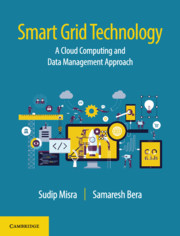Book contents
- Frontmatter
- dedication
- Contents
- Figures
- Tables
- Foreword
- Preface
- Part I Introduction
- Part II Cloud Computing Applications for Smart Grid
- Part III Smart Grid Data Management and Applications
- 11 Smart Meter Data Management
- 12 PHEVs: Internet of Vehicles
- 13 Smart Buildings
- Part IV Smart Grid Design and Deployment
- Index
11 - Smart Meter Data Management
from Part III - Smart Grid Data Management and Applications
Published online by Cambridge University Press: 20 October 2018
- Frontmatter
- dedication
- Contents
- Figures
- Tables
- Foreword
- Preface
- Part I Introduction
- Part II Cloud Computing Applications for Smart Grid
- Part III Smart Grid Data Management and Applications
- 11 Smart Meter Data Management
- 12 PHEVs: Internet of Vehicles
- 13 Smart Buildings
- Part IV Smart Grid Design and Deployment
- Index
Summary
It is evident that smart meters will play a key role in managing real-time energy supply–demand and billing customers, as discussed in Chapter 9. Typically, smart meters are expected to be deployed at the distribution side to monitor real-time power usage by the customers. The smart meters’ information (such as energy demand) is sent to the service providers to take adequate decisions (such as real-time price of energy and switching on more generators). Consequently, it is required to have adequate mechanisms in place to store, manage, and process the smart meter data. In this chapter, we will learn about different methodologies, which are useful to manage smart meter data and take appropriate decisions in order to establish an improved smart grid environment.
Smart Metering Architecture
Figure 11.1 presents a schematic view of the smart metering architecture, while focusing on different layers in smart meter information collection. Smart meters are deployed at the customers’ end to monitor in-house or in-building energy consumption. The data from the smart meters are reported to the utility provider both in real-time and on a day-ahead basis. The information sent by the smart meters are aggregated by multiple aggregators deployed on the distribution side. The collected information is aggregated depending on the content of the information. Further, the aggregated information is stored in the local servers, which are maintained by specific service providers. For simplicity, we can assume that such local servers are maintained by the owners of the micro-grids, in order to have energy consumption information within that micro-grid area. Finally, the information collected from all local servers are stored at the central data center. The data center helps all authenticated users to have real-time energy supply–demand information of all generators and consumers present in the smart grid architecture.
Challenges and Opportunities
In this section, we will discuss some of the challenges and opportunities present in managing smart meter data in the smart grid.
Requirement of scalable computing facility
In the smart grid, there are at least three different energy periods – on-peak, off-peak, and mid-peak, as discussed in Chapter 5. Therefore, the number of customers in different time periods will vary depending on their energy requirements. Consequently, the number of smart meters reporting the real-time energy consumption information will also vary.
- Type
- Chapter
- Information
- Smart Grid TechnologyA Cloud Computing and Data Management Approach, pp. 169 - 188Publisher: Cambridge University PressPrint publication year: 2018



